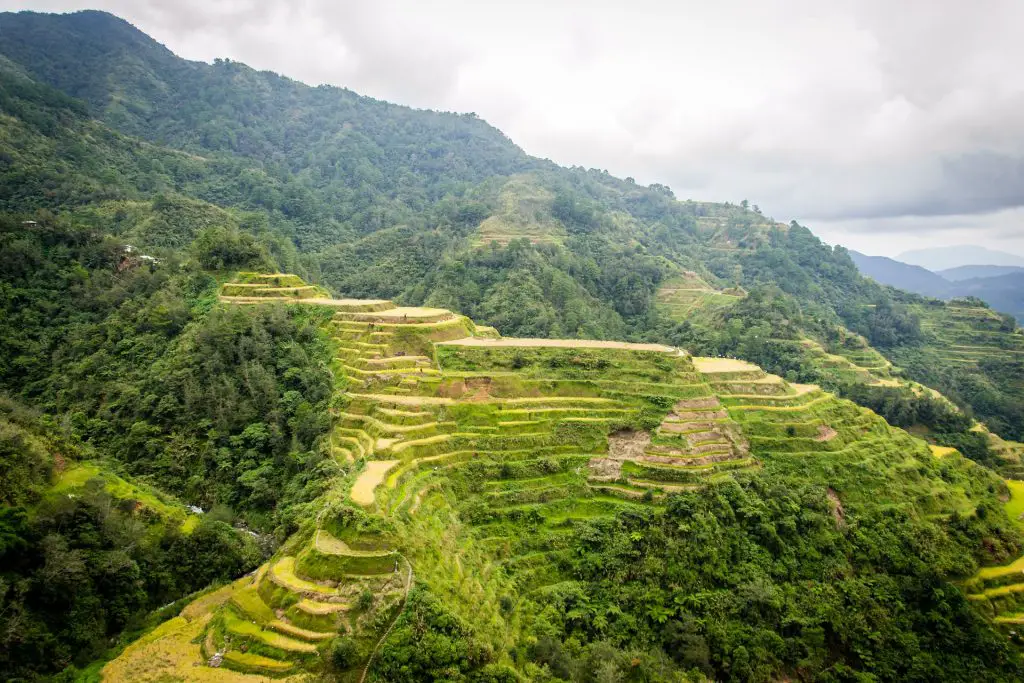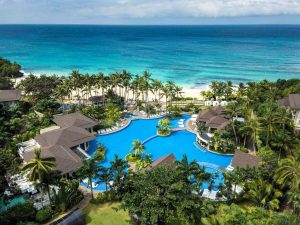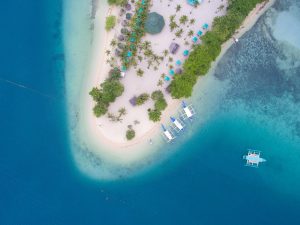The Philippines is an archipelago composed of more than seven thousand islands located in Southeast Asia. Two of these islands are constantly in the top 5 of the world’s most beautiful beaches and islands in the world. While the country is rich in natural beauty like mountains and islands, one of the best things to experience is the Filipino hospitality. When traveling in the country, you will meet friendly locals everywhere who can speak English and communicate with you.
Related Read: Top 20 Best Places to Visit in the Philippines in 2023
I was born and grew up in the Philippines. I started traveling around the country when I worked in a travel agency and continued to work as a travel consultant for an international travel company until now. I’ve had so many friends ask me about how to plan a trip to my country, so I have decided to create this comprehensive travel itinerary.

To plan a trip to the Philippines, one must remember that it is a country surrounded by a body of water. You can only fly into the country, and hopefully stay longer because it will take time or at least two weeks to get to visit some highlights of the country.
Ready to get started? So, here’s an article on how to plan your trip to the Philippines with everything that you need to have the best of your trip.
Planning a trip to the Philippines? Have any questions? Join our Philippine Travel Planning Facebook group here now! It’s the perfect place to ask any questions and to be inspired!
How to Plan a Trip to the Philippines
The Philippines embodies various cultures, mostly Western influences, which you can easily tell from various cuisines and lifestyles in every region. The right blend of Western influence and the original Filipino tradition interests a lot of people which is also one of the reasons why a lot of tourists plan to visit the country. If you’re one of these people who have been eyeing for a vacation in the Philippines anytime soon, this guide will help you with the things you need to know first before visiting the country. Whether you’re a budget backpacker or a luxurious traveler, this guide is for you. You need to plan when to go to the Philippines and how long you want to stay!
The Philippines Map
Do you know that this country is called THE PHILIPPINES? This is because it is an archipelago — a group of more than 7 thousand islands! You’ll surely find all kinds of places that would suit your travel needs.
Before we start, let’s get you familiar with the map of The Philippines. You can see there are many small and big islands, but the major ones are divided into 3 different clusters; Luzon, Visayas and Mindanao. To easily understand it, the northern area is Luzon, the central area is Visayas, and the southern part is Mindanao. Manila — the capital city is located in Luzon.
Is the Philippines safe to travel?
News of the Philippines being unsafe has already reached international media. And honestly, not all of them is very reassuring to read most especially if you are a tourist. The first big question that might pop out from you is this, “Is the Philippines safe to travel?”
During this pandemic times, it is of course not that easy to travel. However, we will be updating this page all the time so you can be sure to have new information with regards to visiting the Philippines.
Well, first, all countries have its safety hazards. The Philippines, in this case, is no exception. Most tourists’ places in the Philippines are safe and have been for many years. Although some tourists noted the presence of armed guards in fast food restaurants and banks as alarming. However, this actually is a good sign for us in the country, note, most of them aren’t loaded or don’t even have ammunition. It means that since there are guards or police visibility, people are more cautious in doing bad things.
Locals can also speak English so asking for help everywhere is easier because there’s no language barrier. As with everywhere we go, it is important to stay vigilant at all times especially when traveling alone too. But overall, I have travelled the country alone and have always felt safe in tourists’ areas.
When to Go to the Philippines
The Philippines is a tropical country which means we experience only rainy and sunny season — in between typhoon season too. From June to November, you’ll expect to experience heavy and continuous downpour with typhoons coming one after another. Sunny season falls in the months of December to May. This is the best time to visit the Philippines because you will be able to enjoy the beaches and can even escape to the mountains without fear of being stuck.
Summer months of April and May are the busiest because even locals are traveling. It’s the perfect time to go lounge at one of the best beaches in Palawan or Boracay. However, they’re also the hottest months which, if you’re not used to the heat, might be too much for you to experience. So, to visit the Philippines, the months of December to May are your best bet.
Travel Booking List and Countdown
If you’re a travel planner like me, there’s no time to lose when planning for your best trip. However, to easily arrange your itinerary with enough time to spare and not get overwhelmed, I’ve listed down the things to do for you to have a great trip to the Philippines.
From 6 months — a year in advance:
• Book your international flights
• Search for best travel insurance for the Philippines
• Plan your itinerary
• Get familiar with the places you want to visit
• List your top 5 places you want to visit
From 3-6 months in advance:
• Book your domestic flights
• Book your accommodation
• Find out how to get from one place to another especially if you need to take ferries and local buses
• Book online for these transfers or your private pick up/drop off
From 1 month in advance:
• Make sure you check passport and visa requirements
• Book your bus or ferry tickets
• Airport arrivals and departures
• Book local tours
• Find the best SIM card for your phone to have internet access and connection
• Print all necessary and important documents, and also send a copy to your email
From 1 week in advance:
• Pack properly
• Double check flight dates, accommodation and bus tickets
Day 1: FLY
How to Travel to the Philippines
To travel to the Philippines, you will probably fly into one of the two major international airports. One is located in Manila (there are actually 4 but one majorly serves international flights) and another one in Cebu. There are many international flights flying into Manila from western countries, while for those around Southeast Asia, Cebu-Mactan International Airport is the best airport to fly into.
Related Read: Ultimate Guide to Cebu Mactan International Airport
To find out cheaper international flights to the Philippines, use Google Flights or Skyscanner to get more options. If you’re flying from Asia — check out Traveloka or official websites of Airasia, Cebu Pacific and Philippine Airlines. These are the major carriers in the Philippines which might give you cheaper rates when you book directly with them.
To travel around the Philippines, it will be more on to flights or ferries. Most of the major ferries and local buses/vans can be booked online too.

Passport and Visa to Visit the Philippines
Traveling to the Philippines is an easy thing to do because foreign nationals coming for tourism or business purposes are only required a valid passport and visa to visit the Philippines. Many nationalities are given a visa on arrival sticker or even a no-visa grant for a maximum of 30 days. You only need to provide a valid return ticket. You can check the official list here.
If you want to stay further than 30 days, it is easy to extend your visa at local immigration office in the city you are currently staying. The cost of the Philippines visa first extension is 3,030 pesos plus 100 pesos for the visa sticker.
READ HERE FOR THE FULL UPDATED VISA AND TRAVEL REQUIREMENTS TO VISIT THE PHILIPPINES
Money and Banks in the Philippines
The Philippine money is called Philippine Pesos. Its equivalent is about $1 = 55 pesos but 50 is generally the average pre-pandemic. The country is still basically a cash society, so it is important to have enough cash with you especially when you go to islands. When arriving at international airports, it would be best to book a grab taxi online, get to your hotel, and then go to a major shopping mall and do your money exchange transactions. ATMs are also in smaller cities and banks but it is difficult to find them in smaller towns.
There are also ATMs which are usually blue that accept international cards in various tourists’ places, be aware that they charge large amount of transaction fees. Your best bet is to make sure you have dollars or pesos in cash and then exchange or withdraw from official local ATM banks when you see one.
Where to Go and Philippines Itinerary
Now where to go in the Philippines? Since there more than 7 thousand islands, we can’t really cover all. So, depending on budget and time, we recommend these top places to visit in the Philippines.
These are the lists of places that we recommend you put on your list of places to visit in the Philippines.
• Manila and nearby areas — the capital city of the Philippines will surely surprise you in many ways. Make sure to check the night-life of Makati and the walled city of Intramuros.
• Cebu — the second biggest city and an island which has balance of city life and beaches. We even wrote a detailed guide on how to visit Cebu.
• Palawan — you’ll find one of the best islands in the world here. Check out El Nido and Coron and decide which one you like best.
• Bohol — a small island packed with adventure, beaches and nature. You’ll surely find it a surprising stop. Read the best things to do in Bohol.
• Boracay — visit the best beach in the world, and enjoy its powdery white sand beach in Boracay. It recently underwent a major rehabilitation that restored its pristine beaches after it fell victim to its popularity– causing it to lose its unspoiled beauty. You can read the best ways to get from Caticlan airport to Boracay.
• Banaue — enjoy the Northern mountain province and see rows and rows of rice terraces carved on mountains.
• Siargao — fulfill you water sports craving with this surfing capital of the Philippines. Here’s our detailed Siargao Travel Guide for your trip planning.
• Siquijor — This small yet surprisingly beautiful and laid-back island has very long stretch of empty beaches, cheap food and cool island vibe.
Of course, there are more places to visit in the Philippines and you’ll surely find the more you search, the more you would like to explore it.
Recommended Group Tours
If you are traveling alone and would like to find people to travel with, there are group tours to the Philippines that you could avail. You can even do this while already in the country.
For group tours, you’ll have a choice of joining a 12-week tour, a Philippine discovery tour or even a Palawan adventure. You can check out all of these Philippine group tours here.
The Best Accommodation Sites for the Philippines
There are many world-class resorts, hotels and local hostels in the Philippines. The best thing to do is to decide where you want to stay and choose accommodation in that area.
Agoda is one of the best booking sites in the Philippines as it has many properties listed even to smaller towns or areas. The other site I like is Hotelscombined because they check all accommodation sites to compare the prices, it also has listed hotels in smaller areas.
Airbnb is not very popular in the Philippines. So there won’t be a lot of options to choose from especially in smaller places. However, if you’re in the bigger cities like Manila or Cebu — you can find condos and apartments on Airbnb that would be better for you to choose from.
How to Go Around the Philippines
The Philippines is composed of many islands, about 7 thousand of them actually. To get around the Philippines, means either flying in or taking ferries. There are also buses in the northern part but for most of the must-see places in the country, flying is the fastest but more expensive option. The more affordable option is taking ferries, and also getting to see different island views along the way. The only disadvantage is it can become bumpy especially if the weather isn’t good.
To fly around the Philippines, you can choose from 3 major airlines — Cebu Pacific, AirAsia and Philippine Airlines. There are also smaller airlines like Skyjet which flies to Coron or El Nido in Palawan.
For buses and ferries, it can be difficult to book in person as you need to go to the terminal/ferry port to get the ticket. The best way to book these tickets is to go online — you can choose your destination here and book your ticket. Like going from Cebu to Bohol. it’s a popular ferry ride.
For airport transfers and arrivals, you can arrange for private pick-ups and transfers, 12go and Bookaway also provide these services. In Manila and Cebu, Grab is your best bet. While in other smaller islands, it is better to book your transfers in advance.
Travel Insurance in the Philippines
The Philippines has amazing doctors and nurses, they’re exported around the world! So, you can be confident that whatever happens to you, you will be given the best medical care. However, make sure that the travel insurance that you get covers weather disturbance and cancellations are this is the major reason for trip cancellations in the country.
What to Pack for a Trip to the Philippines
As someone who likes to pack a week in advance, it is important to know what to bring. Here are some things we recommend for you to pack, and bring to the Philippines.
• Sun Protection Lotion — the lotion you might find here is packed with whitening ingredients so, you better bring your own
• Microfiber Towel — best for the beach and for a cover on an overnight bus
• Universal Adapter — for your gadgets and other equipment
• Power Bank and Portable charger — there can be intermittent power cut-off in different islands, so this is a very useful thing to have
• Comfortable shoes or slippers — remember this is island country, and everyone wears flip flops
• Mosquito repellent — this tropical country will surely make you try to run inside the house at night because of the mosquitoes
• Medicine — make sure you bring your own first aid medicine and anything you are taking regularly
Aside from these, you can find most international food/groceries have what you need, especially in big cities like Manila and Cebu. The Philippines is also a fast-food country so, you can fill your heart with McDonalds but make sure to try the local Jolibee too!
Internet and Phone Coverage
Internet and phone coverage in the Philippines are dismal and quite bad. There are three major telecommunication companies in the Philippines as of writing. PLDT offers Wi-Fi coverage in most tourist areas and bigger cities. Globe and Smart have phone and internet data coverage.
Related Read: Best Prepaid Tourist Sim Card to Use in The Philippines
If you are traveling just in major cities, Globe is your best bet, however, if you’re going to islands, Smart is your better choice. Upon arrival at the airport, you will be offered to buy SIM cards with preloaded data in it. Ask for them to preload your SIM and buy your data coverage good for the number of days you will stay in the country. I would recommend getting the most number as it really is still has bad connection in terms of data, and internet connection in the Philippines.
To make it easier, you can also pre-purchase your SIM card here so, you can just pick it up upon arrival.

Philippine Travel Planning Tips
- Visit places one or two at a time. Sure, you want to explore every Island in the Philippines but with limited time and budget, you might not be able to do so. Moreover, you won’t be able to enjoy and make the most of your trip. For example, you can explore Cebu for a week before going to Bohol for a couple more days. The island of Cebu alone already has a lot of activities stretched out from North to South.
- Bring a universal travel adapter since most hostels, most especially budget hotels or hostels, don’t have available power outlets for every type of plug.
- Bring a power bank to charge your gadgets while on the road or most especially when visiting places with sporadic electric supply. Some remote areas in the Philippines experience rotational power cut off.
- Be patient on the internet speed. As we all know, the Philippines belongs to the countries with a very slow internet connection. Even when staying in the city, slow data coverage or internet speed can still be experienced.
- Bring dry bags or waterproof bags when planning to go island hopping. There are also islands in the Philippines which can be reached by small boat or also known as “Bangka” and putting all your valuables inside a dry bag will keep it safe from the splashing saltwater.
- Don’t forget to apply sunblock and mosquito repellent anywhere you go. To avoid sunburn, use the right SPF level. Also, keep in mind to use reef-safe sunblock if you’re planning to do water activities. Mosquito repellent is also important to avoid mosquito bites and diseases.
- Rent a motorbike to save on transportation costs. The islands of Siargao, Bantayan, and Camotes are few of the top tourist destinations where you can rent a motorbike per day for a cheap price. It is also very convenient if you are planning to DIY you’re itinerary instead of getting a package tour.
Philippines Itinerary/Budget
One of the reasons why a lot of tourists are flocking to the Philippines is because it is a cheap country to travel to. The average cost of food for one day in the Philippines can be as low as $5 if you’re on a tight budget. For the accommodation, you can already find a $14 room or less (but mostly are just bed spaces at this rate). For mid-range travels, the average daily cost of traveling to The Philippines is $49.
The nightlife in the country is also pocket-friendly. You can find very cheap karaoke machines to enjoy with your friends in the city or even along the beach. Beer is inexpensive to that you can afford to buy a bottle or two for a friend. Moreover, a lot of travel agencies are offering affordable Philippine tour packages for a low price but if you want to save more, you can plan your itinerary and adjust it according to your budget. I tried Siargao for 8 days, and I only spent around $150 on the food, surfing, entrance fees to beaches and other tourist spots, accommodation, and other miscellaneous expenses.
Did we miss anything else? Let us know in the comments!
| GO AROUND PHILIPPINES USEFUL TIPS AND LINKS |
|---|
| BOOK YOUR FLIGHTS To travel around the Philippines, there are 3 local commercial airlines. Cebu Pacific Air, AirAsia and Philippine Airlines. Smaller airlines called AirSwift (El Nido, Boracay) and Royal Air also fly to limited destinations. Book your local flights here. For international flights, I found Kiwi and Trip.com have cheaper flight options to the Philippines. |
| BOOK YOUR ACCOMMODATION There are many choices of hotels, hostels, apartments and guesthouses to stay in the Philippines. Book through AGODA for the cheapest options and Booking.com. I also use Hotelscombined to see all prices from different websites to choose from. |
| BOOK YOUR BUS/FERRY/VAN/CAR The Philippines can be difficult to go around because many buses, ferries and even private vehicles are offline. The best websites to book them are through Bookaway.com and 12GoAsia – they have many partners in different destinations and you can purchase tickets online. Car rentals are also available for you to choose from here. |
| BOOK YOUR PACKAGE TOURS If you don’t know where to go and just want a hassle free trip to the Philippines, you can find package trips to different destinations with Klook – I recommend them for local tours and activities or Get Your Guide. |
| DON’T FORGET YOUR TRAVEL INSURANCE |
| It is very important to be safe and ready whenever accidents happen, especially in the Philippines where some places don’t have quality hospitals and clinics. I use Safety Wings for whenever I travel in the Philippines or abroad. |
| Have you got any questions about traveling to the Philippines? Join our Philippines Travel Planning FB Page to get your answers. Don’t know how to start planning your Philippines trip? You can start here. |

Angie is a travel consultant and blogger who has started by writing her travel memoirs on her blog and then got published on international travel sites. She’s now focused on creating in-depth travel itinerary and articles about planning trips to the Philippines.




